Leleupi (Neolamprologus leleupi)
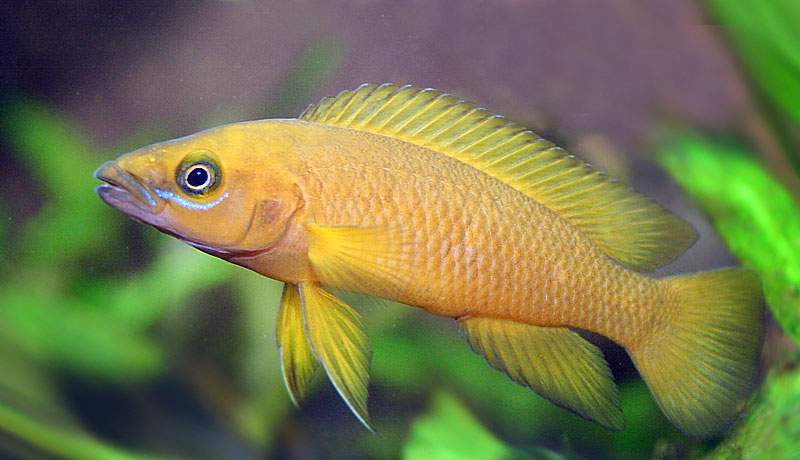 Neolamprologus leleupi in my 240G Lake Tanganyika setup. This fish was born in the tank.
While 50 frontosa are clearly the main interest in this tank, the leleupi with their bright color are certainly giving them a run for their money. I got these from Linda Walrath, a local breeder who is a bit of a celebrity in the cichlid scene with her fantastic fish room. Linda has a great program that she shows at meetings of local fish clubs, which is essentially just a video shot in her fish room going from tank to tank. I believe it's well over an hour, and there is not a second during which you will be bored while watching it. I believe this strain of bright yellow leleupi is a bit of a trademark of Linda's, and I picked up two bags of four fish each at an auction of the Great Lakes Cichlid Society. To bring out the bright yellow of the fish as best as can be, I am sure Linda keeps them over a light substrate. When I put them in my tank with black 3M Color Quartz they certainly darkened, but essentially they are still bright yellow. I am guessing that fish of another strain might well have turned brown. They did develop a dark face mask, however, with the darkest part being the lips. For me this is not a flaw at all, but when kept over a light substrate I am sure it would disappear again. Also, the face mask seems less pronounced in the fry that were born in this tank than in their parents.
As an aside, in a personal communication Linda gave me some interesting information about leleupi breeding. Apparently to develop a nice color, leleupi fry need to be fed quality food with sufficient carotene. Failing that, they will remain the dreary brown color of very young leleupi fry. Furthermore, if due to substandard food the fry have not developed good color at a certain age, later improvement in the food quality will not enable them to gain color. If this is true, it sounds like a great subject for a scientific study.
Neolamprologus leleupi in my 240G Lake Tanganyika setup. This fish was born in the tank.
While 50 frontosa are clearly the main interest in this tank, the leleupi with their bright color are certainly giving them a run for their money. I got these from Linda Walrath, a local breeder who is a bit of a celebrity in the cichlid scene with her fantastic fish room. Linda has a great program that she shows at meetings of local fish clubs, which is essentially just a video shot in her fish room going from tank to tank. I believe it's well over an hour, and there is not a second during which you will be bored while watching it. I believe this strain of bright yellow leleupi is a bit of a trademark of Linda's, and I picked up two bags of four fish each at an auction of the Great Lakes Cichlid Society. To bring out the bright yellow of the fish as best as can be, I am sure Linda keeps them over a light substrate. When I put them in my tank with black 3M Color Quartz they certainly darkened, but essentially they are still bright yellow. I am guessing that fish of another strain might well have turned brown. They did develop a dark face mask, however, with the darkest part being the lips. For me this is not a flaw at all, but when kept over a light substrate I am sure it would disappear again. Also, the face mask seems less pronounced in the fry that were born in this tank than in their parents.
As an aside, in a personal communication Linda gave me some interesting information about leleupi breeding. Apparently to develop a nice color, leleupi fry need to be fed quality food with sufficient carotene. Failing that, they will remain the dreary brown color of very young leleupi fry. Furthermore, if due to substandard food the fry have not developed good color at a certain age, later improvement in the food quality will not enable them to gain color. If this is true, it sounds like a great subject for a scientific study.
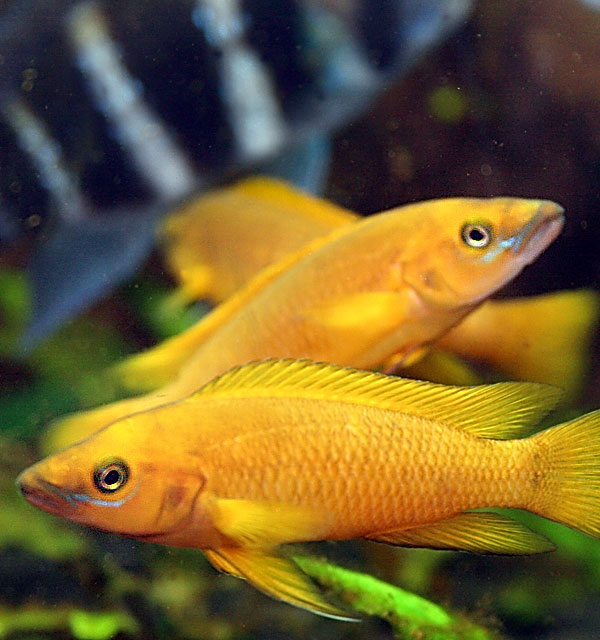 The leleupi are the only fish that enjoy significant breeding success in my 240G. There is at least one breeding pair on the left, and another one on the right hand side of the tank, and there are always small, brown leleupi fry around. Some of them always seem to make it to the stage where they are not easily considered to be food by everybody, and as a result, I now have leleupi of all sizes in the tank. I actually managed to catch some to collect BAP points at some stage, and I grew them out in a 10G with six feedings per day consisting of baby brine shrimp, microworms, and other delicacies. To my surprise their brothers and sisters in the big tank, who received no special care from me, and ate only the leftover food scraps of the big fish, grew about twice as fast as the fry in the 10G. As the breeding success of the leleupi in comparison to for example my cyprichromis shows, substrate spawning like the leleupi practice it ensures greater breeding success in the confined aquarium environment than mouth brooding, despite the fact that mouth brooding is obviously a more evolved form of parental care than substrate spawning. My cyprichromis females are constantly holding in that tank, but the fry invariably become food for others before I can even see them. The cyps obviously raise their fry through mouth brooding until they are able to make it on their own in the lake. However, in a tank environment this size is not enough to ensure survival, presumably because in the limited space is harder to escape predators. The leleupi on the other hand seem to be able to defend at least some fry of each spawn well enough that they survive. As I have outlined elsewhere on this site, in one of my previous setups N. pulcher 'daffodil', who form possibly even more tight-knit family colonies where older fry help the parents to guard the young, vastly out competed mbuna in their fry survival rates when I kept them in the same tank.
The leleupi are the only fish that enjoy significant breeding success in my 240G. There is at least one breeding pair on the left, and another one on the right hand side of the tank, and there are always small, brown leleupi fry around. Some of them always seem to make it to the stage where they are not easily considered to be food by everybody, and as a result, I now have leleupi of all sizes in the tank. I actually managed to catch some to collect BAP points at some stage, and I grew them out in a 10G with six feedings per day consisting of baby brine shrimp, microworms, and other delicacies. To my surprise their brothers and sisters in the big tank, who received no special care from me, and ate only the leftover food scraps of the big fish, grew about twice as fast as the fry in the 10G. As the breeding success of the leleupi in comparison to for example my cyprichromis shows, substrate spawning like the leleupi practice it ensures greater breeding success in the confined aquarium environment than mouth brooding, despite the fact that mouth brooding is obviously a more evolved form of parental care than substrate spawning. My cyprichromis females are constantly holding in that tank, but the fry invariably become food for others before I can even see them. The cyps obviously raise their fry through mouth brooding until they are able to make it on their own in the lake. However, in a tank environment this size is not enough to ensure survival, presumably because in the limited space is harder to escape predators. The leleupi on the other hand seem to be able to defend at least some fry of each spawn well enough that they survive. As I have outlined elsewhere on this site, in one of my previous setups N. pulcher 'daffodil', who form possibly even more tight-knit family colonies where older fry help the parents to guard the young, vastly out competed mbuna in their fry survival rates when I kept them in the same tank.
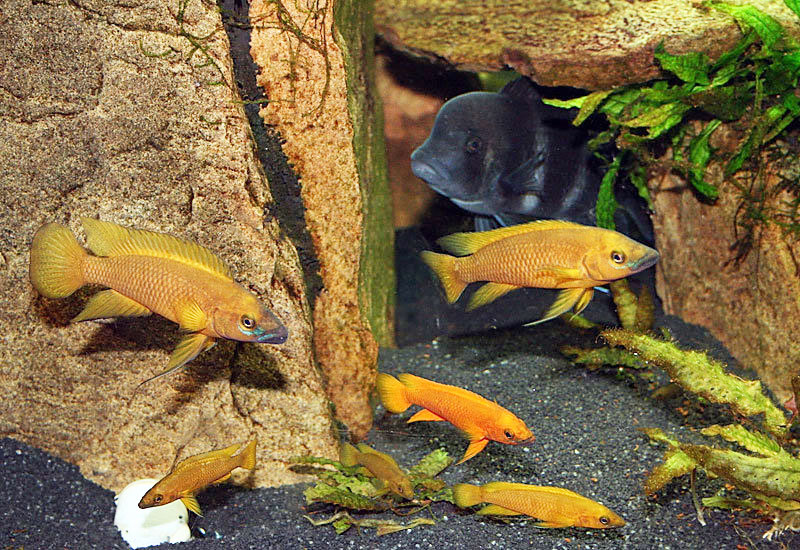 Colony of Leleupi.
Colony of Leleupi.
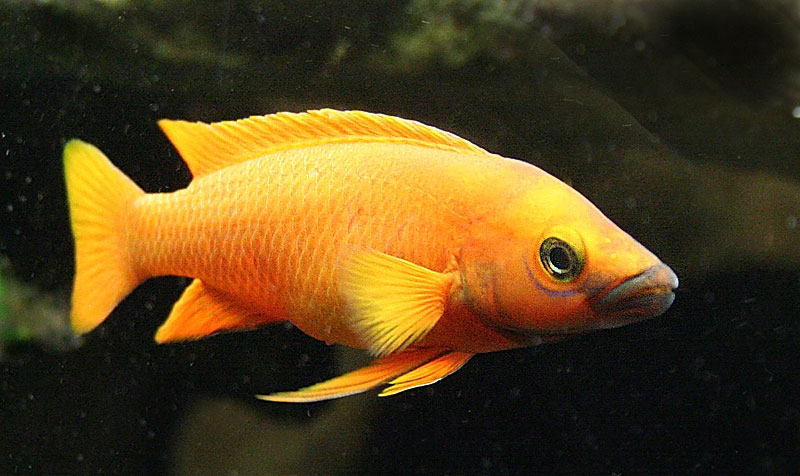 One of my breeding females. This is the most orange leleupi I have. She breeds with a huge yellow male, and their offspring is bright yellow.
One of my breeding females. This is the most orange leleupi I have. She breeds with a huge yellow male, and their offspring is bright yellow.
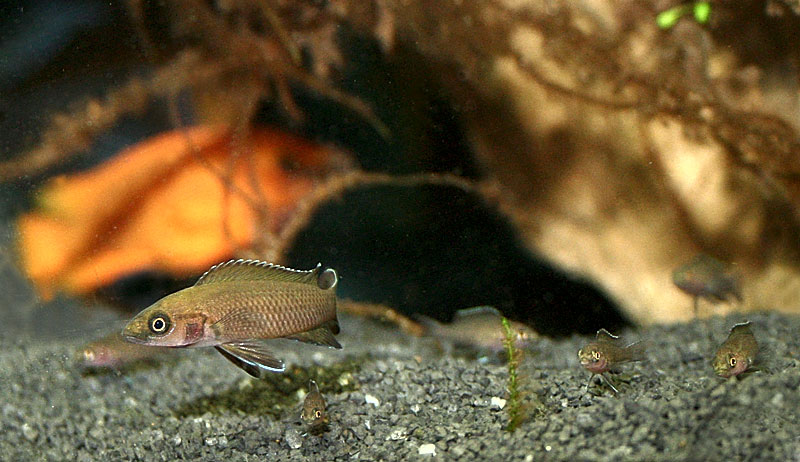 Fry that have only just become free swimming that day being watched by an older sibling. Mom is lurking in the background, and the same fish as in the previous picture. It will take a while for the little ones to color up, but eventually they are going to be as yellow as their parents.
Addendum January 2009
Over the last two years I have easily sold 50-60 N. leleupi from this tank. Since I can never catch the little ones, most of them were adults, including about a dozen very large males. To this date, they remain the only fish that manage to consistently breed and grow up fry in this tank.
Some pictures from January 2009.
Fry that have only just become free swimming that day being watched by an older sibling. Mom is lurking in the background, and the same fish as in the previous picture. It will take a while for the little ones to color up, but eventually they are going to be as yellow as their parents.
Addendum January 2009
Over the last two years I have easily sold 50-60 N. leleupi from this tank. Since I can never catch the little ones, most of them were adults, including about a dozen very large males. To this date, they remain the only fish that manage to consistently breed and grow up fry in this tank.
Some pictures from January 2009.
One Response to “Leleupi (Neolamprologus leleupi)”
Leave a Reply
You must be logged in to post a comment.




August 13th, 2021 at 11:19 am
[…] au moins 3 à 5 couples dans un seul aquarium de 100 litres. Il n’y a plus guère qu’un neolamprologus leleupi pour les accompagner, mais quand même, ça fait […]